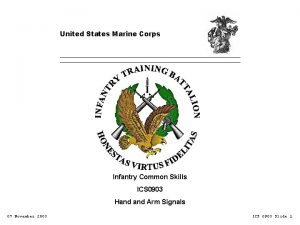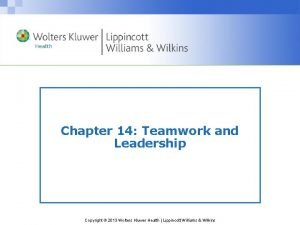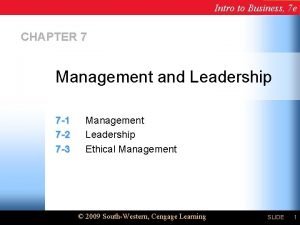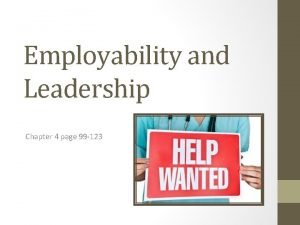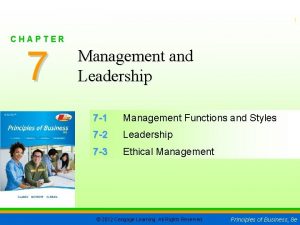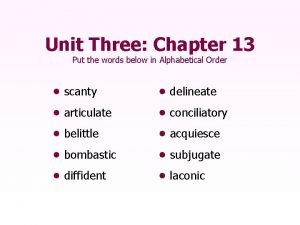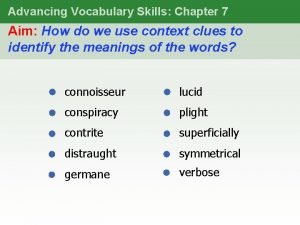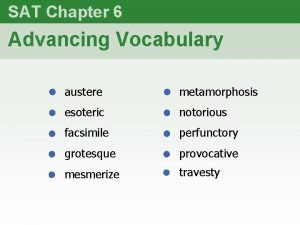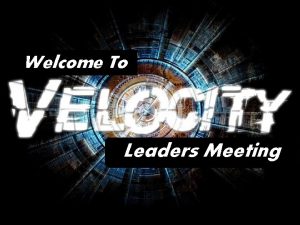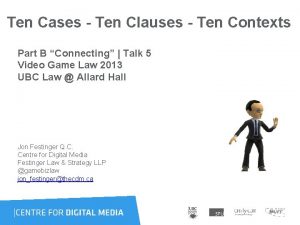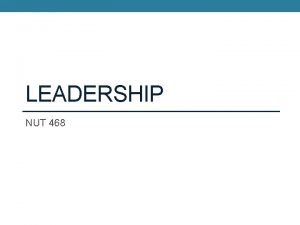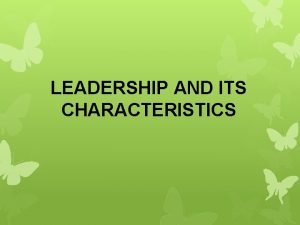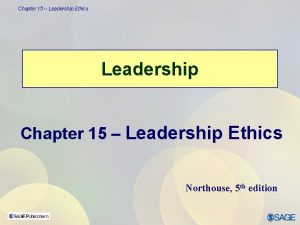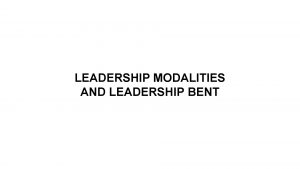Leaders and Leadership Chapter Ten Copyright 2015 Mc








































- Slides: 40

Leaders and Leadership Chapter Ten Copyright © 2015 Mc. Graw-Hill Education. All rights reserved. No reproduction or distribution without the prior written consent of Mc. Graw-Hill Education.

Learning Objectives LO 10 -1 Explain what leadership is, when leaders are effective and ineffective, and the sources of power that enable managers to be effective leaders. LO 10 -2 Identify the traits that show the strongest relationship to leadership, the behaviors leaders engage in, and the limitations of the trait and behavioral models of leadership 10 -2

Learning Objectives (cont. ) LO 10 -3 Explain how contingency models of leadership enhance our understanding of effective leadership and management in organizations LO 10 -4 Describe what transformational leadership is, and explain how managers can engage in it LO 10 -5 Characterize the relationship between gender and leadership and explain how emotional intelligence may contribute to leadership effectiveness. 10 -3

The Nature of Leadership ªLeadership 9 The process by which a person exerts influence over other people and inspires, motivates and directs their activities to help achieve group or organizational goals 10 -4

The Nature of Leadership ªLeader 9 An individual who is able to exert influence over other people to help achieve group or organizational goals 10 -5

The Nature of Leadership ªPersonal Leadership Style 9 The specific ways in which a manager chooses to influence others shapes the way that manager approaches the other tasks of management. 9 The challenge is for managers at all levels to develop an effective personal management style 10 -6

The Nature of Leadership ªServant leaders 9 leader who has a strong desire to serve and work for the benefit of others 9 shares power with followers 9 strives to ensure that followers’ most important needs are met 10 -7

Discussion Question What culture has the most effective leadership style? A. Japanese B. European C. United States D. Middle Eastern 10 -8

Leadership Across Cultures Leadership styles may vary among different countries or cultures 9 European managers tend to be more peopleoriented than American or Japanese managers 9 Japanese managers are group-oriented, while U. S managers focuses more on profitability 9 Time horizons also are affected by cultures 10 -9

Sources of Managerial Power Figure 10. 1 10 -10

Question? What type of power is the ability of a manager to give or withhold tangible and intangible rewards? A. Reward B. Coercive C. Expert D. Legitimate 10 -11

Power: The Key to Leadership ªLegitimate Power 9 The authority that a manager has by virtue of his or her position in an organizational hierarchy ªReward Power 9 The ability of a manager to give or withhold tangible and intangible rewards 10 -12

Power: The Key to Leadership ªCoercive Power 9 The ability of a manager to punish others ªExpert Power 9 Power that is based on special knowledge, skills, and expertise that a leader possesses 10 -13

Power: The Key to Leadership ªReferent Power 9 Power that comes from subordinates’ and coworkers’ respect, admiration, and loyalty. 10 -14

Empowerment: An Ingredient in Modern Management ªEmpowerment 9 the process of giving employees at all levels the authority to make decisions, be responsible for their outcomes, improve quality, and cut costs 10 -15

Empowerment: An Ingredient in Modern Management Empowerment: ª Increases a manager’s ability to get things done ª Increases workers’ involvement, motivation, and commitment ª Gives managers more time to concentrate on their pressing concerns 10 -16

Leadership Models ªTrait Model 9 Focused on identifying personal characteristics that cause effective leadership. 9 Many “traits” are the result of skills and knowledge and effective leaders do not necessarily possess all of these traits. 10 -17

Question? Which leadership model identifies the two basic types of behavior that many leaders engaged in to influence their subordinates? A. Fiedler B. Path-Goal C. Behavioral D. Trait 10 -18

The Behavior Model ªBehavioral Model 9 Identifies the two basic types of behavior that many leaders engaged in to influence their subordinates 10 -19

The Behavior Model ªConsideration 9 behavior indicating that a manager trusts, respects, and cares about subordinates ªInitiating structure 9 behavior that managers engage in to ensure that work gets done, subordinates perform their jobs acceptably, and the organization is efficient and effective 10 -20

Contingency Models of Leadership ªContingency Models 9 Whether or not a manager is an effective leader is the result of the interplay between what the manager is like, what he does, and the situation in which leadership takes place 10 -21

Contingency Models of Leadership ªFiedler’s Model 9 Personal characteristics can influence leader effectiveness 9 Leader style is the manager’s characteristic approach to leadership 10 -22

Contingency Models of Leadership ªRelationship- oriented style 9 leaders concerned with developing good relations with their subordinates and to be liked by them. ªTask-oriented style 9 leaders whose primary concern is to ensure that subordinates perform at a high level and focus on task accomplishment 10 -23

Fiedler’s Model ªLeader–member relations 9 The extent to which followers like, trust, and are loyal to their leader; a determinant of how favorable a situation is for leading. ª Task structure 9 the extent to which workers tasks are clear-cut so that a leader’s subordinates know what needs to be accomplished and how to go about doing it 10 -24

Fiedler’s Model ªPosition Power 9 the amount of legitimate, reward, and coercive power leaders have by virtue of their position 9 Leadership situations are more favorable for leading when position power is strong. 10 -25

Fiedler’s Contingency Theory of Leadership Figure 10. 2 10 -26

House’s Path-Goal Theory A contingency model of leadership proposing the effective leaders can motivate subordinates by: 1. Clearly identifying the outcomes workers are trying to obtain from their jobs. 2. Rewarding workers for high-performance and goal attainment with the outcomes they desire 3. Clarifying the paths to the attainment of the goals, remove obstacles to performance, and express confidence in worker’s ability. 10 -27

House’s Path-Goal Theory ª Directive behaviors 9 setting goals, assigning tasks, showing subordinates how to complete tasks, and taking concrete steps to improve performance ª Supportive behavior 9 expressing concern for subordinates and looking out for their best interests 10 -28

House’s Path-Goal Theory ªParticipative behavior 9 giving subordinates a say in matters that affect them ªAchievement- oriented behavior 9 Setting very challenging goals, believing in worker’s abilities 10 -29

The Leader Substitutes Model ªLeadership Substitute 9 A characteristic of a subordinate or characteristic of a situation or context that acts in place of the influence of a leader and makes leadership unnecessary 10 -30

The Leader Substitutes Model ªPossible substitutes can be found in: 9 Characteristics of the subordinates: their skills, experience, motivation. 9 Characteristics of context: the extent to which work is interesting and fun. 10 -31

Transformational Leadership ªTransformational leadership 9 Makes subordinates aware of the importance of their jobs and performance to the organization by providing feedback to the worker 9 Makes subordinates aware of their own needs for personal growth and development 9 Motivates workers to work for the good of the organization, not just themselves 10 -32

Being a Charismatic Leader ªCharismatic Leader 9 An enthusiastic, self-confident transformational leader who is able to clearly communicate his or her vision of how good things could be 10 -33

Stimulating Subordinates Intellectually ªIntellectual Stimulation 9 Behavior a leader engages in to make followers be aware of problems and view these problems in new ways, consistent with the leader’s vision 10 -34

Engaging in Developmental Consideration ªDevelopmental Consideration 9 Behavior a leader engages in to support and encourage followers and help them develop and grow on the job 10 -35

Transactional Leadership ªTransactional Leaders 9 Leaders that motivate subordinates by rewarding them for high performance and reprimanding them for low performance 10 -36

Gender and Leadership ª The number of women managers is rising but is still relatively low in the top levels of management. ª Stereotypes suggest women are supportive and concerned with interpersonal relations. ª Men are stereotypically viewed as being directive and focused on task accomplishment. 10 -37

Emotional Intelligence and Leadership ªThe Moods of Leaders: 9 Groups whose leaders experienced positive moods had better coordination 9 Groups whose leaders experienced negative moods exerted more effort 10 -38

Emotional Intelligence and Leadership ªEmotional Intelligence 9 Helps leaders develop a vision for their firm 9 Helps motivate subordinates to commit to the vision 9 Energizes subordinates to work to achieve the vision 10 -39

Video: Japan CEO ªWhy does the CEO of Japan Airlines take a bus to work? ªWhat style of leadership does, CEO Naruka Nishimatsu, exhibit to his employees? 10 -40
 Copyright 2015 all rights reserved
Copyright 2015 all rights reserved Copyright 2015 all rights reserved
Copyright 2015 all rights reserved Ten twenty thirty forty fifty sixty seven
Ten twenty thirty forty fifty sixty seven Ten ten siempre fuerzas y esperanza
Ten ten siempre fuerzas y esperanza Ten ten program
Ten ten program Transactional leadership vs transformational leadership
Transactional leadership vs transformational leadership What is adaptive leadership theory
What is adaptive leadership theory Adaptive leadership vs situational leadership
Adaptive leadership vs situational leadership Chapter 18 adjustments and the ten-column worksheet answers
Chapter 18 adjustments and the ten-column worksheet answers The intellectual and spiritual leaders.
The intellectual and spiritual leaders. Reconnaissance and surveillance leaders course
Reconnaissance and surveillance leaders course What is deca's mission
What is deca's mission Disregard previous command hand and arm signal
Disregard previous command hand and arm signal Dla etid
Dla etid Chapter 7 management and leadership answer key
Chapter 7 management and leadership answer key Chapter 14 teamwork and leadership
Chapter 14 teamwork and leadership Intro to business chapter 7 study guide
Intro to business chapter 7 study guide Chapter 4 employability and leadership
Chapter 4 employability and leadership Chapter 4 employability and leadership
Chapter 4 employability and leadership Chapter 7 management and leadership
Chapter 7 management and leadership Meaning of articulate
Meaning of articulate Complete the review with the words below check out
Complete the review with the words below check out What are the ten essentials of a successful ffa chapter?
What are the ten essentials of a successful ffa chapter? Chapter 16 sentence check 2
Chapter 16 sentence check 2 Chapter 13 ten words in context sentence check 2 answers
Chapter 13 ten words in context sentence check 2 answers Chapter 25 ten words in context
Chapter 25 ten words in context Chapter 23 sentence check 2
Chapter 23 sentence check 2 Chapter 12 sentence check 1
Chapter 12 sentence check 1 Ten words in context chapter 10
Ten words in context chapter 10 Sentence check 1 chapter 3
Sentence check 1 chapter 3 Ten words in context chapter 2
Ten words in context chapter 2 Chapter 1 ten principles of economics
Chapter 1 ten principles of economics Chapter 6 sentence check 1
Chapter 6 sentence check 1 Ten words in context chapter 7
Ten words in context chapter 7 One of the ten principles of economics in chapter 1
One of the ten principles of economics in chapter 1 Ten principles of economics chapter 1
Ten principles of economics chapter 1 Chapter 6 ten words in context
Chapter 6 ten words in context What are the ten essentials of a successful ffa chapter
What are the ten essentials of a successful ffa chapter Saasta astro quiz 2015 questions and answers
Saasta astro quiz 2015 questions and answers Astro quiz 2021 round 2
Astro quiz 2021 round 2 Leedy and ormrod
Leedy and ormrod












